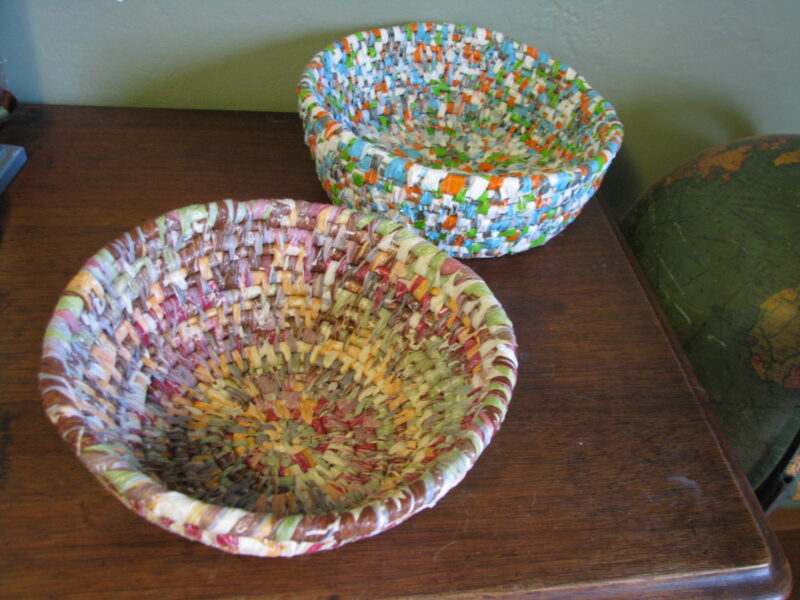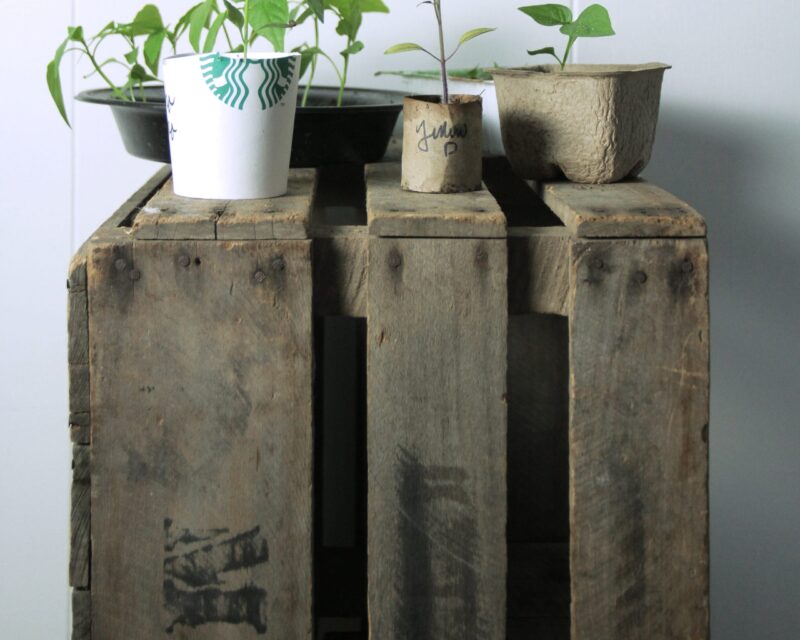Introduction
Recycling is important for managing waste and conserving resources. It helps reduce waste and the need for new materials, as well as energy usage, pollution, and greenhouse gas emissions.
But recycling doesn’t have to be limited to putting items in the blue bin. There’s a whole world of creative possibilities beyond that, known as upcycling.
What is Upcycling?
Upcycling is a form of recycling where you take something that would normally be thrown away and turn it into something new and useful. It’s like giving new life to old things!
Unlike traditional recycling, which involves breaking down materials to make something else, upcycling focuses on finding new ways to use existing items without changing them too much.
The great thing about upcycling is that it not only helps the environment by reducing waste but also allows you to express your creativity and innovation. You can create unique pieces that reflect your style and personality while making a positive impact on the planet.
In this guide, we’ll explore different upcycling ideas that you can try at home. So gather your materials and get ready to unleash your artistic side!
The Benefits of Recycling
Recycling is not just about being environmentally responsible; it’s a practical solution that brings considerable benefits for the planet and economy alike. Let’s delve into the benefits of recycling to understand the positive impacts it can create.
Environmental Impacts
Recycling plays a significant role in minimizing environmental degradation. When you recycle, you help:
- Reduce Landfill Waste: Each item recycled is one less adding to the already overflowing landfills.
- Conserve Natural Resources: Recycling ensures we use fewer raw materials, protecting our natural resources from depletion.
- Decrease Energy Consumption: Manufacturing products from recycled materials often requires less energy compared to starting from scratch with raw materials.
- Prevent Pollution: Recycling can significantly cut down on pollutants released into our air and water during the production process.
Economic Advantages
The economic benefits of recycling cannot be underestimated, as it contributes to job creation and cost efficiency:
- Job Creation: The recycling sector creates jobs in sorting and processing recyclable materials.
- Cost Efficiency: Businesses can save money by using cheaper, recycled materials instead of expensive raw ones.
Solid Waste Management Strategy
Incorporating recycling into our daily lives is an effective solid waste management strategy. It helps us manage the overwhelming volume of waste generated daily, maximizing resource utility and minimizing environmental harm.
By segregating waste, reusing what we can, and recycling what’s left, we can:
- Reduce the volume of waste that goes to landfills
- Save energy that would otherwise be expended on waste treatment
- Create valuable commodities out of waste
Understanding these benefits underlines why everyone should embrace recycling as part of their lifestyle.
Creative Recycling Ideas for Everyday Items
As we explore creative recycling, let’s start with everyday items like plastic bags and wraps. These common items often end up in landfills or oceans, causing environmental problems.
1. Repurposing Plastic Bags and Wrap

Plastic bags and wraps are convenient but harmful to the environment. When not disposed of properly, they can take a long time to break down and harm plants and animals.
Innovative Reuses for Plastic Bags
Instead of adding to the issue, here are some ways you can use your plastic bags again:
- Plastic Bag Yarn: Also known as plarn, this is a clever way to turn unwanted plastic bags into material for crafts. Cut the bags into strips and connect them to make a long string. You can then knit or crochet with this plarn to make reusable bags, mats, or accessories.
- Packing Material: Instead of using bubble wrap, you can crumple up plastic bags to protect delicate items during shipping.
- DIY Greenhouse: Covering plants with a clear plastic bag creates a small greenhouse that keeps in moisture and warmth, helping them grow.
How to Reuse Plastic Wrap
Plastic wrap is another item we often throw away without thinking. But it can have a second life too:
- Sealant Aid: When applying caulk around windows or doors, skip the tape and use strips of plastic wrap to define the area.
- Funnel: If you don’t have a funnel on hand, roll up some plastic wrap into a cone shape as a temporary substitute.
Responsible for Recycling Plastic Bags and Wrap
When you can no longer reuse plastic bags and wrap, it’s important to recycle them correctly. Most regular recycling programs don’t accept these items because they can cause problems at recycling facilities. Instead, look for special bins at stores or recycling centers in your area that specifically collect plastic bags and wrap.
Remember, creative recycling is not just about finding new uses for things but also reducing waste and making sure materials are disposed of properly. This way, we can help create a more sustainable future.
Transforming Furniture and Home Decor

When it comes to creative recycling ideas, the realm of furniture and home decor offers a treasure trove of opportunities for repurposing items. By embracing the concept of upcycling, you not only reduce waste but also add a personalized charm to your living space. Upcycling allows you to reuse materials in new and inventive ways, ensuring that the lifecycle of everyday objects is extended far beyond their original intent.
The Power of Repurposing Furniture and Upcycling Home Decor
Repurposing furniture and upcycling home decor can transform how you view items that may seem outdated or redundant. An old piano gathering dust can become the centerpiece of a room once again, not as an instrument but as an innovative bookshelf or even a quirky planter. Similarly, suitcases with travel-worn edges can stack up to form a unique side table with hidden storage.
“Each of these projects not only serves a practical purpose but also carries with it a narrative—a second chance at usefulness, a new form of beauty.”
Reuse materials like plastic bags and plastic wrap in smaller decor projects such as weaving them into outdoor mats or fusing them into fabric-like sheets for crafting.
Creative Ideas for Furniture and Home Decor Upcycling
Here are some creative ways to breathe new life into common household items:
Old Pianos
- Bar Conversion: Strip out the internal mechanics and retrofit with shelves and a wine rack for a conversation-starting bar.
- Bookshelves: Utilize the open lid and sturdy frame to display books, transforming the piano into an artistic library.
Suitcases
- Pet Beds: Line with comfortable fabric for an instant cozy nook for cats or dogs.
- Wall Shelves: Mount small suitcases on walls for floating shelves with built-in storage.
Pallets
- Garden Planters: Disassemble and reconfigure into box planters for a rustic garden addition.
- Coffee Tables: Sand down, stain, or paint, then add wheels or legs for a chic living room piece.
Tips for Your Furniture and Home Decor Transformations
Consider these additional tips when embarking on your furniture and home decor transformations:
- Inspect: Check the structural integrity of the item before starting. Ensure it’s stable enough for its new purpose.
- Plan: Sketch designs or create mood boards to visualize your project before diving in.
- Prepare: Gather all necessary tools and materials for your project.
- Personalize: Tailor your project to reflect personal style or functionality needs.
By repurposing furniture and upcycling home decor, you play an active role in reducing waste while showcasing creativity. These endeavors contribute positively to the environment by diverting items from landfills and reducing the demand for new products. So next time you contemplate discarding an old item, pause to consider its potential for transformation—your next favorite piece of furniture or decor could be hiding within it.
Also Read:
- Insulating Your Home Without Insulation: A Clever Solution for Energy Efficiency
- Transforming Your Small Backyard on a Budget: Beauty and Functionality Combined
- What is Bokashi? How to Compost More of Your Kitchen Waste
- Transform Your Kitchen with These Remodeling Tips
- Fun Ways to Update Your Home Decor on a Budget
3. Giving New Life to Electronics and Appliances

In our rapidly advancing digital age, outdated electronics and appliances often meet an unfortunate fate, ending up in landfills as e-waste. E-waste is a significant issue that contributes to environmental degradation, but it’s also a golden opportunity for creative recycling.
The improper disposal of electronics and appliances not only adds to the growing pile of waste but also poses hazardous risks due to the toxic substances they contain. Yet, with a dash of creativity and a commitment to sustainability, you can breathe new life into these items.
Unconventional yet Effective Ways to Repurpose Old Electronic Devices and Household Appliances
Here are some unconventional yet effective ways to repurpose old electronic devices and household appliances:
- Creative Uses for Old Computers: Don’t let your old computers collect dust. With some elbow grease, you can turn them into intriguing decor pieces or functional items. An old Macintosh can be transformed into a quirky cat bed or a chic mini bookshelf. Even computer components can serve new purposes. Circuit boards can be crafted into coasters, while keyboards can morph into unique wall art.
- Upcycling Old Televisions: If you have an old box TV lying around, consider turning it into a vintage pet house or even a cocktail bar. These televisions also make for excellent retro fish tanks, offering your aquatic pets an unexpected home.
- Repurposing Kitchen Appliances: Large kitchen appliances like refrigerators can be creatively recycled too. An unused fridge can become an outdoor storage unit or even be converted into a stylish planter for your garden.
- Old Bike Parts and Trampolines: Unconventional items such as old bike parts and trampolines offer numerous possibilities for upcycling. Old bicycle wheels can transform into charming chandeliers or wall clocks, while trampoline frames can serve as the base for hanging garden beds or even circular swing sets.
- Transforming Sea Mines into Furniture: For a showstopping piece of upcycled decor, consider transforming an old sea mine into a unique piece of furniture. This isn’t for the faint-hearted but serves as a testament to how even the most unlikely items can be creatively recycled.
These examples underline that with imagination and resourcefulness, you can give almost any item a second life. By repurposing electronics and appliances, not only do you reduce waste and conserve resources, but you also create something truly unique and personal.
As we continue to consume electronic goods at an unprecedented rate, it becomes crucial to think about what happens to these items when they reach the end of their life cycle. By embracing creative recycling ideas, you can contribute to a more sustainable future while indulging your creativity.
15 Household Items to Repurpose for Home Organization [Youtube]
Showcasing Extraordinary Upcycling Projects
Filled with innovative recycling ideas and creative repurposing tactics, the world of upcycling is bursting with potential. From small-scale home décor pieces to large architectural structures, there’s no limit to what can be achieved with a bit of ingenuity and unwanted materials.
One man’s trash is truly another man’s treasure. This statement holds special significance in the realm of upcycling projects. So, let’s dive into some extraordinary creations that have transformed discarded items into something valuable and aesthetic.
The Bottle Houses of Prince Edward Island
On the quiet shores of Canada’s Prince Edward Island, one can find a remarkable sight – houses made entirely out of recycled glass bottles. The brainchild of builder Édouard T. Arsenault, these structures are prime examples of how innovative recycling ideas can lead to beautiful, practical, and environmentally friendly solutions. Arsenault used approximately 25,000 bottles to construct three whimsical buildings—a six-gabled house, a tavern, and a chapel—each one a testament to the magic that can happen when creativity meets recycling.
Vinyl Record Art
For music lovers who have vinyl records collecting dust in their basements, here’s an artistic way to give them new life. Artists around the globe are transforming these vintage items into spectacular works of art. From intricate wall clocks to decorative bowls and even stunning murals, these creations prove that old records can hit all the right notes in terms of aesthetics and sustainability.
Recycled Bike Part Chandeliers
Why toss away old bike parts when they can light up your life? Crafty artisans have been turning rusty gears, worn-out chains, and discarded wheels into striking chandeliers—a stellar example of upcycling that combines style with sustainability. These unique fixtures not only add industrial charm to any space but also serve as a vibrant conversation starter about the importance of creative repurposing.
These innovative projects are a fraction of the boundless possibilities that recycling and upcycling present. With just a little creativity and initiative, you too can transform everyday waste into something extraordinary.
Incorporating Recycling into Your Daily Routine
The journey towards an environmentally conscious lifestyle starts at home. If you’re ready to start reducing waste, the first step is creating a recycling routine.
Step 1: Sort Your Waste
Start by designating separate bins for different types of recyclables in your home. This can be as simple as having one bin for paper, one for plastic, and another for glass and metal. By sorting your waste, you not only make the recycling process smoother but also cultivate awareness about the waste you generate.
Step 2: Make Sustainable Choices
Choosing products with recyclable packaging is another practical way to support your recycling efforts. Before purchasing an item, check if its packaging is recyclable or if there’s a similar product available with less packaging.
For instance,
If you notice a large number of plastic bottles in your bin, it might be time to consider switching to a reusable water bottle.
Step 3: Embrace Other Sustainable Habits
While recycling plays an essential role in reducing waste, it’s equally important to embrace other sustainable habits. Consider these points:
- Mindful Consumption: Be aware of what you buy and why you’re buying it. Do you need it? Can you borrow or rent it instead? By asking these questions before making a purchase, you can reduce unnecessary consumption.
- Composting: Organic waste like fruit peels, coffee grounds, and eggshells can be composted at home to create nutrient-rich soil for your plants.
- Repair and Reuse: Before throwing away a broken item, consider if it can be fixed or used for something else. This habit not only reduces waste but also saves money.
Incorporating recycling into your daily routine might require some adjustments initially but remember,
Small actions, when done consistently, can lead to big change.
As we move forward in this guide, let’s continue exploring how creativity and innovation can breathe new life into discarded materials.
Conclusion
The actions you take, whether small or grand, play a crucial role in paving the way for a sustainable future. Through recycling and upcycling projects, you contribute to reducing waste and conserving resources.
This guide has illuminated the path towards transforming everyday items into innovative creations that not only serve a purpose but also tell a story of mindful living.
- You’re invited to harness your ingenuity and embark on an upcycling project that resonates with you.
- Draw inspiration from the ideas detailed throughout this guide and let your creativity lead the way to repurposing items with your unique touch.
Innovation remains key in our collective quest to address the global waste challenge. As we continue to explore new avenues for reusing materials, remember that every creative endeavor you undertake is a step towards a cleaner, more resourceful world. Let’s commit to this journey together, fostering solutions that will echo through our communities and inspire generations to come.
FAQs(Frequently Asked Questions)
The economic benefits of recycling include cost savings from reusing materials, job creation in the recycling industry, and reduced expenses for waste disposal.
You can repurpose plastic bags and wrap them by using them for various purposes such as making crafts, lining trash cans, or even creating outdoor cushions.
Creative ideas for furniture and home decor upcycling include transforming old furniture with new paint or upholstery, repurposing items into storage solutions, and creating unique decorative pieces from salvaged materials.
You can incorporate recycling into your daily routine by sorting your waste, making sustainable choices when purchasing products, and embracing other sustainable habits such as reducing water and energy consumption.
Extraordinary upcycling projects include the Bottle Houses of Prince Edward Island, vinyl record art, and recycled bike part chandeliers, which demonstrate the creative potential of repurposing everyday items.
Here are some unconventional yet effective ways to repurpose old electronic devices and household appliances: consider turning an old computer monitor into a fish tank, transform an outdated microwave into a storage cabinet, or repurpose an unused washing machine drum as a stylish coffee table.
Consider these additional tips when embarking on your furniture and home decor transformations: explore unique paint techniques to revitalize old furniture, repurpose household items into decorative pieces, or incorporate sustainable materials into your upcycling projects.
Citation
- Faleide, L.S. (1990) Creative Recycling at Home.(Faleide, 1990)
- Bone, E., and Pratt, L. (2012) Recycling Things to Make and Do. Usborne Books. (Bone and Pratt, 2012)
- Blossom (2019) 15 Clever Ways to Upcycle Everything Around You!! Recycling Life Hacks and DIY Crafts by Blossom. Available at: https://www.youtube.com/watch?v=fGqfWvm4TnQ (Accessed: 29 December 2023).
Perla Irish, who is more familiarly known as Irish, is the Content Manager at newfld.com. She loves following trends around home and garden, interior design and digital marketing. Through this blog, Irish wants to share information and help readers solve the problems they are experiencing.
